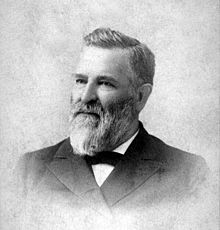Robert Waterman (governor)
| Robert Whitney Waterman | |
|---|---|
 |
|
| 17th Governor of California | |
|
In office September 12, 1887 – January 8, 1891 |
|
| Lieutenant | Stephen M. White |
| Preceded by | Washington Bartlett |
| Succeeded by | Henry Markham |
| 17th Lieutenant Governor of California | |
|
In office January 8, 1887 – September 12, 1887 |
|
| Governor | Washington Bartlett |
| Preceded by | John Daggett |
| Succeeded by | Stephen M. White |
| Personal details | |
| Born |
December 15, 1826 Fairfield, New York |
| Died | April 12, 1891 (aged 64) San Diego, California |
| Political party | Republican |
Robert Whitney Waterman (December 15, 1826 – April 12, 1891) was an American politician. He served as the 17th governor of California from September 12, 1887 until January 8, 1891.
Waterman was born on December 15, 1826 in Fairfield, New York. He was born to John Dean Waterman and Mary Graves Waldo. His middle name derives from the second wife (Clarissa (Dwight) Whitney) of his maternal grandfather. He had seven siblings, including James Sears Waterman, John Calvin Waterman, Henry Franklin Waterman, Charlotte Judith Waterman, Mary Waterman, Charles Waterman, Caroline Waldo Waterman, and Theodore Francis Waterman.
Waterman moved to Newbury, Illinois when he was thirteen to join his brother as a clerk. Until 1850, he was a store clerk and postmaster in Geneva, Illinois. In 1850, he sold his assets and headed to California. He traveled with F.A. Park, and befriended Brigham Young in Salt Lake City along the way. When he arrived in California, he joined one of his brothers prospecting near the South Fork of the Feather River on Oregon Creek. In 1851, Waterman returned to his family in Wilmington, Illinois and became a successful grain dealer. He returned to Illinois, and helped form the Illinois Republican party in 1854 and published the Willmington Independent newspaper. In 1856, he was one of two Illinois delegates to the first Republican National Convention in Bloomington, Illinois. The other was Abraham Lincoln. In 1860 he played a key role in delivering Illinois to Abraham Lincoln.
In 1873, Waterman returned to California and became a machinery salesman in Redwood City, California. In 1874, he moved to San Bernardino, California. He operated the Stonewall Jackson Mine which netted him $500 a day.
In 1880, while residing in San Bernardino, Waterman discovered a silver mine with John Porter a few miles north of Barstow, California, then called Grapevine. In 1881, he formed a mining partnership with John Porter called Waterman and Porter, with 3/4 of the interest owned by Waterman. A stamp mill settlement about four miles (6 km) away was named Waterman. The Southern Pacific Railroad came through Waterman in 1882 and 100 men were employed at the mill and mine. The mine produced 40,000 tons of ore worth US$1.7 million before it closed in 1887 after silver prices declined.
...
Wikipedia
